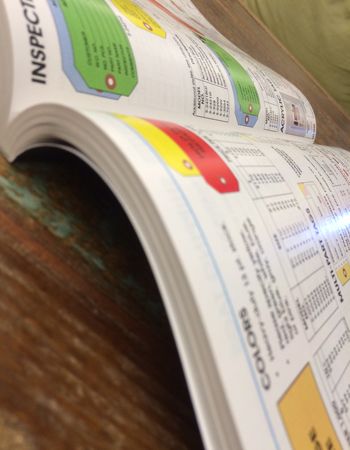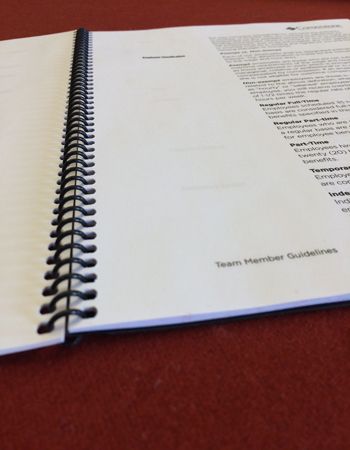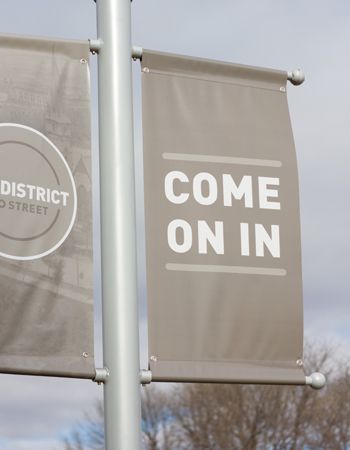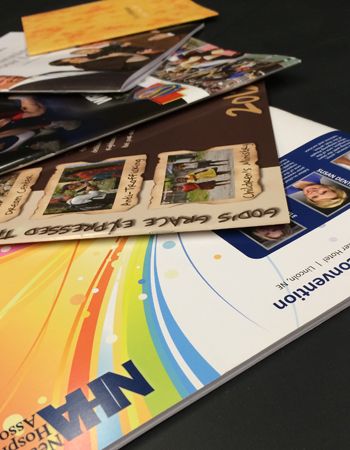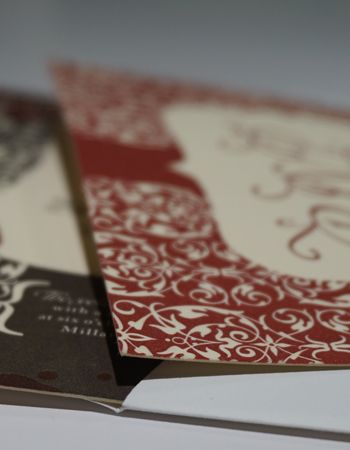
Here you'll find answers to common questions our clients ask. Start by selecting one of the links below. If you don’t see what you need – call or contact us online.
- At what resolution should I save my photos and graphics?
- How do I go about getting an estimate from you?
- How long does it take for you to complete my order?
- Is white considered a printing color?
- Tips on how to save your design files
- What file format should I use when submitting my electronic document for printing?
- What is a "proof"?
- What is the Pantone Matching System?
- What kind of work does our plant do?
- Why do the printed colors look different from the colors on my screen?
-
At what resolution should I save my photos and graphics?
Resolution should be set to 300 dpi.
Pictures and graphics pulled from the internet are often low resolution, typically 72 dpi or 96 dpi. Avoid these graphics, as they will appear pixilated and blocky when printed.
Also note that you should save all photos in CMYK mode, not RGB mode when possible. Images saved in RGB mode may not print properly. If you are unable to save your image in CYMK mode, please let us know.
-
How do I go about getting an estimate from you?
Well, since you are here, we would suggest you use our online estimate request form. Or you can fax specifications to us at 412-731-2268.
If you have complicated or specific concerns, be free to give us a call and talk with one of our customer service representatives.
-
How long does it take for you to complete my order?
There is not a short answer to this question because that completely depends on the scope and size of your project. However, "turning projects around" is a strength of ours and we actually position ourselves as a printer who can help solve a tight schedule problem.
We have turned smaller lithographic jobs overnight. And we also condensed schedules on huge magazines which were delayed to prepress by late advertisers. We have several jobs every week that need this kind of horsepower and benefit from our agility in solving a schedule problem.
Nevertheless, it is always better to discuss your delivery needs early, and map out a comfortable schedule to complete the project.
Generally, if turnaround is not critical, small to average size projects will turnaound in one week to 7 days, but often less. And a large project like a multipage magazine may take 7-10 business days. Very large books, specialty bindings, or complicated die cuts, may take longer.
In any case, please give us a call to discuss your project and your turnaround needs. If your needs are tight, we can work with you to plan a solution and make it happen.
-
Is white considered a printing color?
Not typically. Because white is the default color of paper, it is simply recognized as the absence of any ink. However, when using colored paper, white ink may be used if any text or graphic requires it.
-
Tips on how to save your design files
Make them print ready and acceptable for us to print.
COREL DRAW:
Saving your Corel Draw file as an Adobe Illustrator EPS
• Embed all Images
• Convert all your text/copy to outline fonts
• Export as Illustrator EPSFREEHAND:
• Embed all Images
• Convert all your text/copy to paths
• Export as Illustrator EPS or PDFPAGEMAKER:
Saving your PageMaker file as an EPS
• Embed all Images
• Convert all your text/copy to outline fonts
• Export your file as an EPS using the below settings:
Postscript Level 2
CMYK Mode
TIFF format and
BinaryPUBLISHER:
You will need to have the full version of Adobe Acrobat PDF. If you don’t please download and use our Adobe Job Ready Program. If you do have the full version of Adobe Acrobat PDF please follow the steps below.
Under File, Print, select Adobe PDF writer
Under Properties select Press Quality and Save your PDF -
What file format should I use when submitting my electronic document for printing?
PDF (Portable Document Format) is the most common and preferred file format for submitting digital documents. With the installation of a PDF print driver on your computer, virtually any program can generate a PDF file suitable for printing. Both commercial and free PDF print drivers are available online for download from different sources.
-
What is a "proof"?
A proof is a way of ensuring that we have processed your files accurately and that everything is conforming to your requirements. Typically, we will produce a proof which can be sent to you online or process them on our digital IRIS proofers. We can also produce halftone generated proofs for those critical situations.
All of our proofs are made from digital ripped files, and they are already paginated according to our digital press layouts. They represent exactly what will be imaged on printing plates, or other output. So when you get our proofs, all of the prepress activities have been completed, including all the engineering for proper running, binding, and finishing. The last step is imaging plates for press after your approval to do so.
When you approve these proofs, you are authorizing us image these plates. And you are letting us know that we can now schedule our presses for your job.
-
What is the Pantone Matching System?
The Pantone Matching System (PMS) is a color reproduction standard in which colors all across the spectrum are each identified by a unique, independent number. The use of PMS allows us to precisely match colors and maintain color consistency throughout the printing process.
-
What kind of work does our plant do?
Our core business is sheetfed lithographic printing and finishing. We have several full size 40" presses, half size presses, and a variety of specialty duplicators and high speed envelope presses. We have 6 color presses with aqueous coating capabilities, and perfecting presses for 1 over 1 and 2 over 2 printing.
For finishing, we have everything one might need to final finish products from each press format size. This includes large and small folders, including double gatefolding, in house stitching/booklet makers, and a variety of other finishing equipment.
This mix of equipment allows us cover a large gamut of printing products. These include products like magazines down to simple brochures and data sheets. The multicolor presses handle high quality printing, like annual reports, where corporate spot colors may be used. And quantities can range from a few hundred, on our small format press, to 100's of thousands, on our large format presses.
Finally, the small duplicators and high speed envelope presses, are a great fit for products like stationery or short run postcards.
Please give us a call if you want to discuss your specific project, or need more information. Chances are that your project will fit our capabilities, but if not, we'll be happy to direct you to a reputable resource who can likely help you.
-
Why do the printed colors look different from the colors on my screen?
In short, printers and monitors produce colors in different ways.
Monitors use the RGB (red, green, blue) color model, which usually supports a wider spectrum of colors. Printers use the CMYK (cyan, magenta, yellow, black) color model, which can reproduce most—but not all—of the colors in the RGB color model. Depending on the equipment used, CMYK generally matches 85–90% of the colors in the RGB model.
When a color is selected from the RGB model that is out of the range of the CMYK model, the application chooses what it thinks is the closest color that will match. Programs like Adobe Photoshop will allow you to choose which color will be replaced. Others may not.




